The Wonders of Bird Watching in Scotland
Ever wondered what makes birding in Scotland an irresistible adventure? Well, today we are going to embark on a spontaneous flight into the world of Scotland’s bird life, where we’ll introduce you to five of the most incredible species that call this country their home or temporary nesting grounds. This blog builds on our previous exploration of Scotland’s iconic mammals and dives into another part of nature, the feathered wonders that grace the countries skies. As a fellow enthusiast who finds joy in exploring the untamed beauty of Scotland’s bird life and wildlife, join us on a journey to uncover 5 incredible species. We’ll guide you through where and when to spot them and equip you with the knowledge to recognise them.
Atlantic Puffin
Nestled amidst Scotland’s rugged coastal landscapes lies a spectacle that steals the heart of all enthusiasts birding in Scotland, this is the Atlantic Puffin. These charming seabirds have a black back, white underparts, and a large triangular bill striped in bright red, blue, and yellow. Gracing our shores from April to August they choose to nest on soft soil cliff tops, often within underground burrows. Remarkably puffins usually return to the same burrow year after year.
Instead of huffing and puffin in anticipation, plan your visit strategically for a front-row seat to view their cute waddles and aerodynamic displays. While puffins can be spotted on parts of the mainland, the most expansive colonies are seen on puffin trips to the Isle of Staffa, Isle of Canna, Orkney, or the renowned Isle of May. These islands become vibrant nurseries during the breeding season.
Our preferred destinations for puffin encounters include the Isle of Canna and Staffa. These locations aren’t just puffin paradises but offer the opportunity to encounter other species like European Shags, Razorbills, Guillemots, and the Northern Fulmar whilst taking in the incredible volcanic landscapes. As summer bids farewell, puffins embark on an incredible migration journey, spending the winter months bobbing in the cold sea and fishing. This leaves us eagerly awaiting spring, where, without fail, they return, signaling the onset of the breeding season and the renewal of the puffin spectacle along the coastal cliffs of Scotland.
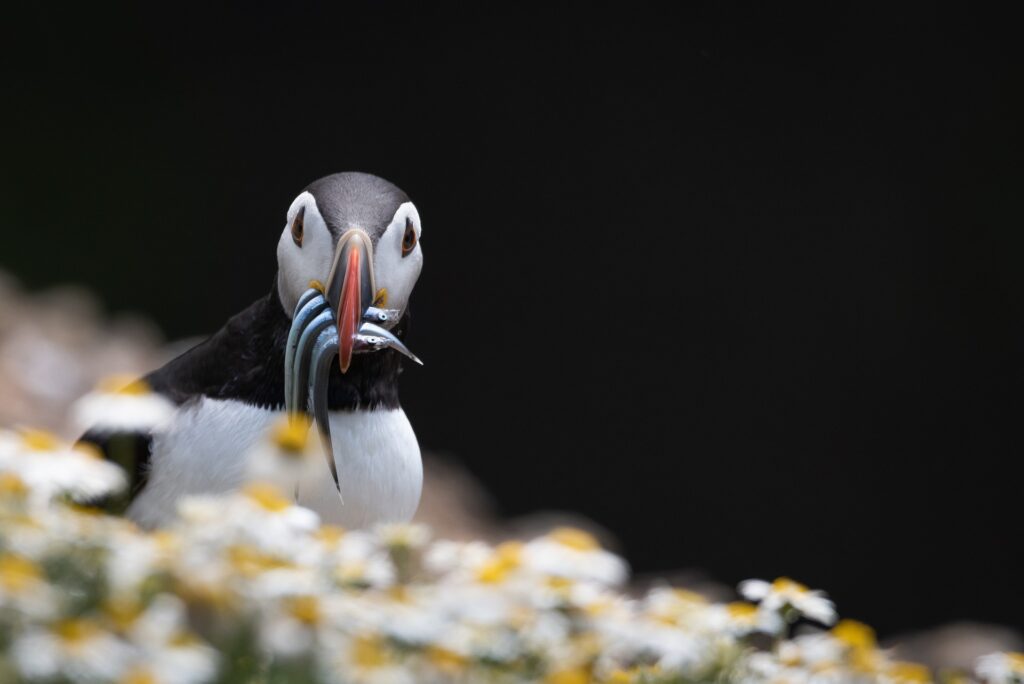
Atlantic Puffin
Has learning about bird life in Scotland made you want to experience it in person?
Click here to inquire about a guided Scotland Birding tour
White-Tailed Sea Eagle
In the realm of Scottish wildlife, the White-Tailed Sea Eagle stands as the UK’s largest bird of prey. With an impressive wingspan reaching up to 2.5 meters, these majestic birds soar above the rugged coastline and inland lochs, creating a breathtaking sight. A prime example is captured in the photo below, showcasing a Sea Eagle on the Isle of Skye coast.
The White-Tailed Sea Eagle in Scotland represents a heroic conservation story. Once declared extinct in Britain during the early 1900s, these magnificent birds have made a remarkable comeback, thanks to a pioneering re-introduction initiative. Chicks were carefully transported from Norway to the rugged landscapes of the Isle of Rum where the Sea Eagles began to thrive once again.
In contrast to their golden eagle counterparts, Scotland sea eagles prefer nesting in sheltered locations such as lochs or sea lochs, steering clear of exposed coastal environments. Choosing trees as nesting sites, these eagles establish territories for life, making them a rare yet observable presence in these areas with around 40 breeding pairs. Prime locations for sightings include the Isle of Mull, Fife, and Wester Ross.
Embarking on the quest to spot these predators scouring the ground before executing a precise dive to secure its prey with razor-sharp talons, leaves an indelible mark on one’s memory. The sea eagle is distinguished by its sheer size, obvious primary feathers, pale head and a distinctive white tail. Juveniles, on the other hand, present a stark contrast, their plumage characterised by a dark and shaggy appearance. Many Sea Eagle tours offer immersive experiences, involving boat trips roaming the coast or journeys to the Isle of Mull, where specially designed Sea Eagle hides enhance the chances of encountering these majestic creatures up close.
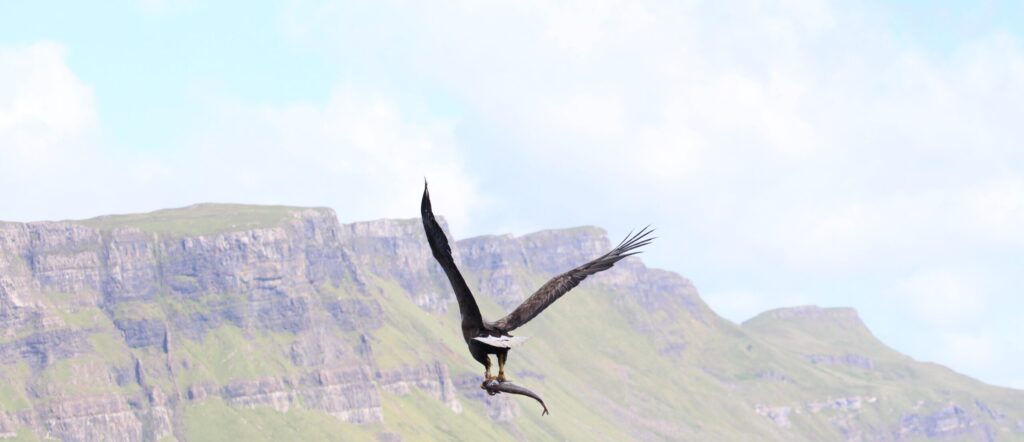
Sea Eagle on the Skye coast
Kingfisher
Encountering a kingfisher in Scotland is a jaw-dropping spectacle. These famously colourful birds, have a striking mix of electric blue backs and metallic copper breasts and grace the surroundings with their vibrant presence. Often found near slow-moving, shallow rivers and streams, these jewel-toned birds can be observed perched quietly on low-hanging branches over the water.
Equip with remarkable eyesight and depth perception, kingfishers employ a fascinating routine to secure their prey. Identifying their target, they seal their third eyelid, a protective and transparent layer. With astonishing agility, they seamlessly dive into the water, using their long, pointed beaks to snatch their prey. Once the fish is pulled from the water, they repeatedly strike it against a branch to finish it off before finally engulfing it for dinner.
The name “kingfisher” is well-earned, as these birds consume the equivalent of their own body weight in fish daily. This daily routine of catching prey and the subsequent unique behavior of finishing it off against a branch mark them as fascinating creatures in the natural world.
For birdwatchers in Scotland, witnessing a kingfisher in action is a majestic encounter, whether it’s perched on a branch or momentarily hovering before a dive. The quest to identify these dazzling birds adds an element of excitement and requires patience from nature enthusiasts. For those eager to observe kingfishers, the elusive birds find refuge in locations like Montrose Basin and the Falls of Clyde, offering enthusiasts two promising spots to catch a glimpse of these creatures in their natural habitat.
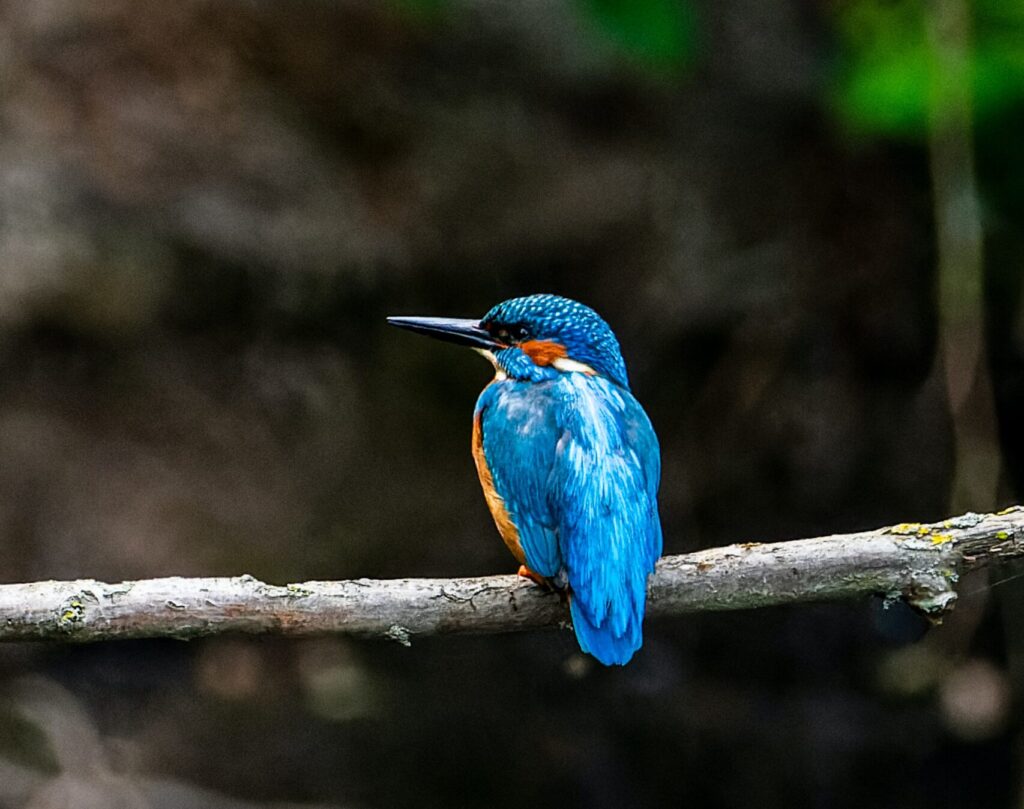
Kingfisher
Golden Eagle
Scotland’s open, mountainous terrains and vast moors are graced by the presence of golden eagles, symbols of power and grace. Nesting on rocky cliff faces or in trees, golden eagles display remarkable fidelity to their territories, often using the same nest for successive generations. These magnificent birds are recognisable by their dark brown plumage, piercing eyes, with adult golden eagles having a golden sheen on the back of their heads and necks. Young golden eagles, in their early years, showcase distinct white patches at the base of their tails and in their wings.
Nesting with fidelity on rocky cliff faces or in trees, golden eagles often reuse the same nests across successive generations. Witnessing their aerial acrobatics, characterised by soaring and gliding on air currents with wings held in a shallow ‘V,’ is a captivating experience. Notable regions for observing these majestic birds include Argyll, Galloway, Mull, Skye, and Glen Affric, each offering a unique vantage point for birding in Scotland. The Outer Hebrides, boasting approximately 90 breeding pairs, house over a fifth of the Scottish golden eagle population. The vast and undisturbed landscapes of the Outer Hebrides, combined with the absence of competing predatory mammals like foxes, create an ideal habitat for the thriving population.
Golden Eagles are on the top of the Scottish food chain, displaying formidable hunting skills, preying on a variety of wildlife including rabbits, mountain hares, foxes, young deer, and large birds like grouse. These massive birds of prey are a common sight making them a focal point for Scotland bird watching enthusiasts. Their presence adds a dynamic and untamed element to the Scottish wilderness.
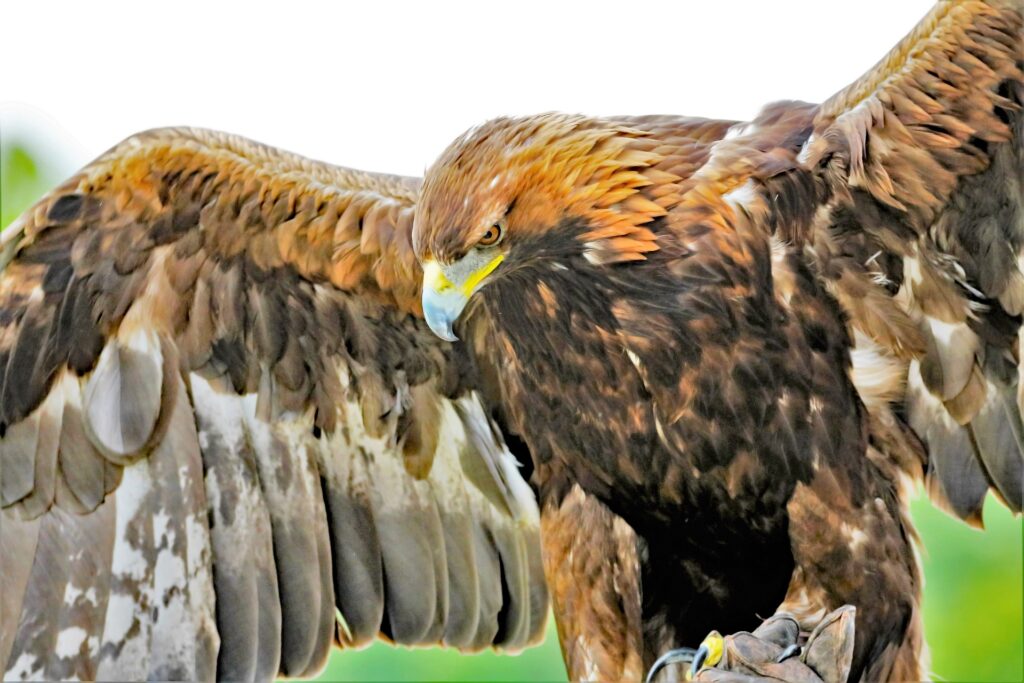
Golden Eagle
Osprey
As a migratory bird, Scotland ospreys appear between March and September. Trackers have shown that these remarkable birds embark on a 6,000km journey from West Africa to Scotland, drawn by the extended daylight hours during the Scottish summer. This extended daylight provides more opportunity for the father Osprey to hunt fish by sight to feed the whole family. There are also fewer predators in the country that will threaten their eggs and flightless chicks during and after breeding season (late March to July) compared to animals like jackel, cobras or eagle owls or in Senegal!
Ospreys are frequently spotted near freshwater lochs and rivers, showcasing their prowess as exceptional fishermen. Hovering above the waters, Ospreys employ their keen eyes to spot fish beneath the surface. The dramatic spectacle of an Osprey’s dive, characterised by unmatched precision and speed, never fails to leave observers in awe. The birds’ long, muscular legs play a crucial role in hunting, allowing them to stretch beneath the water’s surface to snatch fish from affect a remarkable 30-meter dive. Their leg strength also enables them to hold the caught fish in a head-first aerodynamic position while in mid-air, until arriving at a perch for some a la carte dining.
To identify an Osprey, look for distinctive features such as a dark eye stripe and a white head, along with an impressive wingspan that can reach up to six feet. Ospreys strategically choose nest locations near water sources to optimise their access to fish, making nests on Loch Garten, Loch Arkaig, and Loch of the Lowes ideal for birdwatching. As summer arrives, these locations showcase a seasonal abundance of catchable trout, attracting Ospreys with their prime fishing conditions. Where insects rise to the surface, transforming into adult flies ready for breeding. This natural cycle becomes a spectacle as trout follow the insects towards the water’s surface, bringing them within the top meter or so of the loch, perfect hunting grounds for Ospreys.
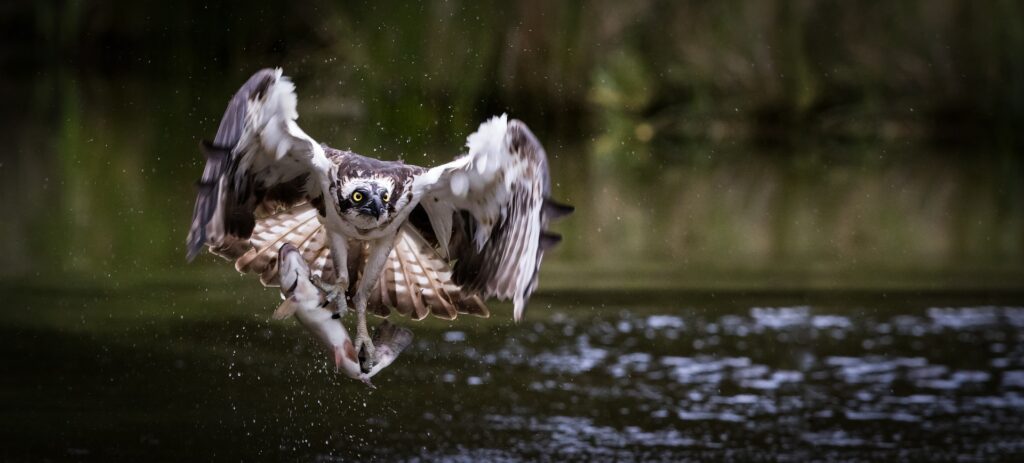
Osprey
As our exploration of birding in Scotland unfolds, we’ve soared through the realms of the puffin, the sea eagle, the golden eagle, the osprey, and the kingfisher. Each species adding a unique layer to Scotland’s natural beauty awaiting bird watchers and wildlife enthusiasts alike.
Beyond the birds which we have discussed today, there awaits a multitude of other fascinating species, ready to be discovered through Scotland bird watching or our upcoming blog posts. From the Goldfinch to the Waxwing, the Red Kite, the Mandarin Duck, the Hen Harrier and much more.
As we conclude our avian tales, we invite you to feather our blog with your thoughts. Whether you’re an experienced birder or a newcomer to Scotland wildlife, your reflections and experiences are valuable. Drop us a comment or a direct message, we’d love to hear from you.
For those eager for a Scotland wildlife tour, consider joining us on an unforgettable journey. Whether you’re a seasoned birder or just beginning your bird watching in Scotland, we can curate a bespoke tour. Let us weave together the magic of nature and the allure of history.